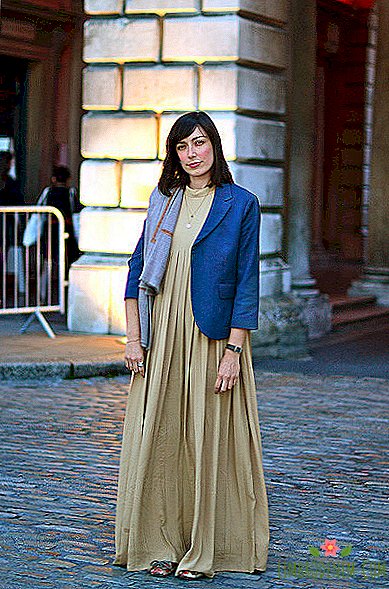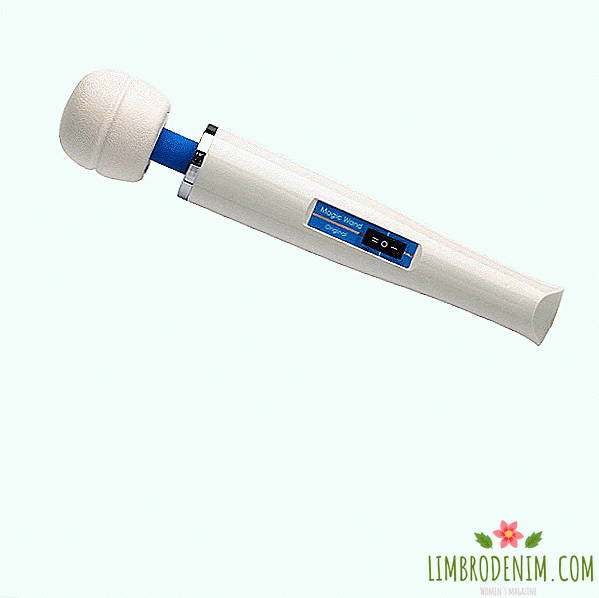How sexuality returns to fashion
Every modern designer and the fashion house sees a woman in its own way: someone in a micro-cut with a deep neckline, someone in sweatpants and a panama, someone in strict neutral things. How many people - so many offers. Nevertheless, historically, the conflict of two female images, which gives rise to differences and stereotypes. There is a traditional notion of "femininity" where the heroine is sexy by default and the clothes should emphasize the figure. This image is contrasted with androgynous things in a masculine style or completely borrowed from a man’s wardrobe (horror, sports and shapeless), as a rule, hiding the figure and always going under the label "anti-sex". Although we are well aware that a woman can be even more beautiful and attractive without makeup and in a men's suit than with false eyelashes and in a dress with an animal print, the question remains: what kind of female clothes can be considered sexy and which one is not, and should is it anyway to be?

Back in 1879, an Englishwoman, Mary Eliza Khos, wrote in the book "The Art of Dress": "The costume always balances between your need to be seen or, on the contrary, to be closed. For example, it is permissible to open a small part of the body, but everything else should be completely covered. Someday, people will immediately open their arms, shoulders, legs, even their breasts or something else. " When in the XX century the historical framework of the class was weakened, and women had more freedoms, eroticism began to appear in their clothes. It was then that we saw "something else." We can recall the first works of Madeleine Vionne, who in the 1920s draped thin pleated silk on the figure of women, saying that the corsets are not needed, and the athletic body is already a corset. The openness of clothes was also added by the fashion of the flappers: they themselves decided to emancipe whether to smoke them or not, when to wear stockings and dresses on thin straps with beads, and when men's suits. This, by the way, was harmony.
Of course, a certain length of the dress and the height of the heel can drastically change the mood. But the concept of sexuality is associated primarily with the inner feeling, and not with clothes and shoes. Another question is important: for whom we dress? The short and sexy dress, in the opinion of society, implies that it is worn to attract the attention of men, and the idea of dressing up for yourself is in doubt. Most of the naked body is associated with sex, although it can be, for example: a) just a body; b) manifesto; c) a work of art.
Both parties to the conflict are now reconciling in their own way the modern faces of the power women generation from the field of pop culture: Beyonce, Kim Kardashian, Niki Minaj and their colleagues. On the one hand, it seems that they seem to continue the traditions of the club rasta-style of the 80s, which arose at the dawn of the hip-hop movement in Jamaica. This style assumed undisguised sexuality: dresses from the grid, a lot of gold, bra-tops, Lurex, thongs - and influenced the whole hip-hop culture and style of its heroines. However, due to climatic conditions and ease of attitude to life, local residents were always relaxed and calmly walked half-naked, and the legacy remained impressive.

On the other hand, modern heroines obviously perceive their body as their own wealth, and clothing as a free choice. New sexuality develops along the same trajectory with the growing popularity of strong women, and this is not a new phenomenon - exactly the same right of women to control their own sexuality and emphasize it was indicated by the lipstick feminism movement, and one of its brightest representatives in pop culture can be called Madonna of her time 1990 "Blond Ambition" tour. The pop diva in her aggressively sexy corsets and cone-shaped bra, created by Jean-Paul Gautier, personified sex as strength and power, self-expression, and not a tool of seduction. It was the era of supermodels: Linda, Naomi and Cindy proudly carried their sexuality, and brands like Gucci and Versace created the appropriate outfits for them.
The desire for modesty or frankness in fashion is largely due to ideas about the body. In the 21st century, it became important to be healthy and energetic, to go in for sports and to eat properly for one's own good (and not for having the perfect body as a weapon of excellence) - this is the new wellness, the ideology that replaced the materialism of the 2000s. Modern fashion to this request immediately responded. Women like a toned body, so why not show it? So, one of the main trends of the next year is clothing made of transparent fabrics. A good example is the appearance of Rihanna in a transparent dress at the CFDA Prize, with which she clearly marked the trend. You can also recall the masters of 2015, bra-tops and low-waisted trousers that make it clear - if you want to look fashionable, be in shape.
Moreover, nudity today can be a manifesto, just like in the 60s: compare the recent social campaigns "Free the Nipple" and the rhetoric of California nudists of the 1960s. Then, marginal openness became synonymous with sincerity and the struggle for individual rights, and the sexual revolution became one of the forms of protest against political aggression, in particular the war in Vietnam. In 1968, the newspaper Matrix wrote: "It is extremely important to deprive the genitalia of special sacral significance. Having exposed them, people will no longer be afraid of them. Hiding the body, they try to hide that they are ugly and dirty." Full or partial abandonment of clothing of that time also coincided with the consumerist boom of the era, and nudity became an antidote to the culture of uncontrolled consumption.

On the other hand, fashion exploits sexuality year after year for the simplest reason: sex sells - and today's rehabilitation of overt dresses can be attributed to the need to overcome the sales crisis. Gianni Versace in one of his last interviews in 1997 said: "I would be a very rich man if I could make sexy clothes." Then he, of course, was shy. After all, the most striking example, which has already become a caricature, is the glamorous era of the late 1990s and early 2000s, when Versace outfits looked in place. The image of that time is easy to imagine: these are feminine clothes, often unnecessarily elegant, artificial beauty (all built up) and the heels that were suggested to be worn from dawn to dusk. The problem was not so much that these attributes of the epoch were vulgar, but that they were massively imposed on the media as the only true ones and were accompanied by magazine tips on how to dress up to seduce and certainly marry. It is not surprising that with the gradual independence, many girls wanted to quickly forget these recommendations, like a bad dream, and switched to laconic things, sports and clothing and shoes in men's style.
And although in the history of world fashion the kitsch of the 2000s was only a period long written off in textbooks on the history of fashion, in Russia its traces are still a guide to action. Unisex of the 90s was weak in our country, existed in the underground somewhere at the level of the Pop-Mechanics party of Kuryokhin, then - a thin layer of intellectual bohemian in black total bows of Belgian and Japanese designers, and did not get accustomed in wide circles. Exactly the opposite - the basis of the foundations is still the glamorous sexy fashion, and in half-secular circles, brands like Roberto Cavalli and unnaturally plump lips still remain in favor. Just look at the shooting in 2014 in glossy magazines and turn on the TV. The logic of many Russian women is simple: "If not smart and not fit, then why buy?". One of my friends to the question why she bought a hat with rhinestones, replied: "Well, why? After all, so ... like a woman!"
If you look at what is happening all over the world, then it is clear that the brands began to massively reject the screaming sexuality in the 2010s, switching to minimalism and comfort. For many, this has only benefited. For example, with the arrival of Raf Simons, Dior has become cleaner than under Galliano, or Versace, having removed all unnecessary, now look fresh and modern. Here you can recall Gilles Zander and Phoebe Failo, who set the image of a modern woman and explained that the skirt is just a skirt, and trousers are just pants and things that do not require excessive adornment. All these examples are perfectly suited to the new spirit of the time when women are building a career, are not in a hurry to jump out of marriage and dress for themselves. And then another extreme happened, and we came across another limitation: sexually feminine clothes were completely out of fashion and in fact became a taboo. The apex of androgyny, sport and masculine style became the autumn-winter collections of 2014, when the catwalks were all wide trousers, heavy materials like leather, wool and suede, skirts below the knees, voluminous sweaters, bulky jackets with pockets, rough shoes and sportswear style.

However, the new collections of 2015 brands are radically different from this. Mini-skirts, dresses in obtyag, ultrashort shorts, transparent things opening the chest, deep cuts and cuts on clothes, transparent tights and boots forgotten are back in fashion. Stylists of brands are adopting style techniques of the early 2000s, as if within the framework of a postmodern joke (in fact, not). For example, Alexander Wang, after the androgynous collection, switched to sexy skin-tight dresses and heels in the new season. It is important that the shoes in the collection resemble sneakers, and this is a strong gesture denoting: "At this point, there could no longer be just sneakers." Moreover, the brand has already shown the pre-autumn collection of 2015 and we can judge well in advance that it will be fashionable in exactly one year: and here you have skirts paired with fishnet tights and suede half boots (hello, 2000s!).
Similarly, the last collections of Christopher Kane have changed: in the fall we see the male style, in the spring - transparent and silk dresses. Kane also makes fun of the 2000s and works in contrasts: the scourge of fashion of the time, the leopard and the lace are perfect models with a zero-hairstyle, which stylists usually used in combination with rude things. Ashish Gupta was replaced by cropped tops and mini skirts with sequins, “stripper” shoes, decorated with fluff. Jonathan Anderson, after an asexual collection with floor-length skirts, switched to a mini, open belly and fitted silhouettes. We see the Swedes Acne in the transition from androgyny to femininity: in the fall there are wide trousers and midi length skirts, in the spring open chest, mini-skirts, micro-shorts and transparent tops.
Judging by the new shows, designers are trying to find a balance between the concepts of "sexy" and "stylish", and the best thing in these attempts to rehabilitate eroticism is a healthy sense of humor. Miuccia Prada in the new season of 2015 for Miu Miu is reviving pencil skirts, cropped shirts, deep V-necklines, suede brown boots, decorative feathers and hairstyles in the spirit of mid-2000s graduates. Jeremy Scott literally quotes elements of the fashion of the 2000s since the fall and continues the theme in the new Barbie collection. Collections of Stella McCartney and Phoebe Failo in the new season also look more sensual than autumn. Phoebe, for example, retains strict silhouettes, but adds a mini length and cutouts, revealing a naked body.

The brands for which sex has always been part of the DNA are also interesting in this respect. Their collections in the new season look absolutely on the verge. Take, for instance, Givenchy: Ricardo Tishi shows women dominant in leather stockings, whose image resembles Lindy St. Clair. The brand’s latest advertising campaign twists this image to its limits: the model sits on the shoulders of a naked man (and there’s always a woman in the newly naked sexual bonus in advertising) Another example is Balmain: Olivier Rustin told the Style.com interview: "Let's free the nipple, you know what I mean? " - And for the advertising company at home he took Kim Kardashian. A completely radical example is Tom Ford, which led the house to success thanks to the controversial exploitation of female sexuality, and in the new season showed transparent dresses with overlays on nipples.
"Clothing is sex, and the ability to do it to one degree or another dictates what to wear today," writes Hadley Freeman from The Guardian. K-HOLE, for example, believes that style is a repetition of things that a man put on last time with the intention to have sex. So which clothes are considered sexy and which ones are not? The answer is simple: any. Both sex and fashion imply freedom of choice, and this is what should be guided by. In the end, sexy dresses and transparent things are pushing us to learn more about our sexuality, which is great. The only thing we lack is a healthy attitude towards it - so that it can be demonstrated without the threat of becoming a victim of physical violence or being condemned by society. If changes in consciousness occur, a short skirt will never again become an excuse for a man whistling after us, and sweatpants and sneakers will be a reason for comments, “Oh, so where is femininity?”.





